

Filippo Brunelleschi. Italian architect.
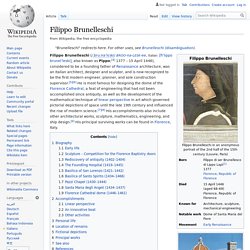
Christian Norberg-Schulz. Biography[edit] Thorvald Christian Norberg-Schulz was born in Oslo, Norway.
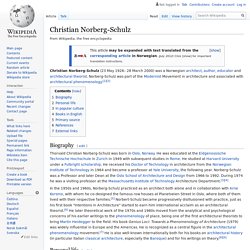
He was educated at the Eidgenossische Technische Hochschule in Zurich in 1949 with subsequent studies in Rome. He studied at Harvard University under a Fulbright scholarship. He received his Doctor of Technology in architecture from the Norwegian Institute of Technology in 1964 and became a professor at Yale University, the following year. Norberg-Schulz was a Professor and later Dean at the Oslo School of Architecture and Design from 1966 to 1992. Personal life[edit] Michelangelo. Francesco di Giorgio Martini. Extract from a notebook of Francesco di Giorgio Martini, 1470 Francesco di Giorgio Martini (1439–1501) was an Italian architect, engineer, painter, sculptor, and writer.
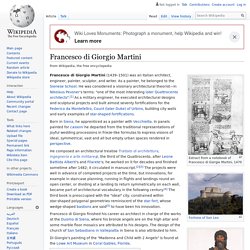
As a painter, he belonged to the Sienese School. He was considered a visionary architectural theorist—in Nikolaus Pevsner's terms: "one of the most interesting later Quattrocento architects".[1] As a military engineer, he executed architectural designs and sculptural projects and built almost seventy fortifications for the Federico da Montefeltro, Count (later Duke) of Urbino, building city walls and early examples of star-shaped fortifications. St John the Baptist, 1464 at Museo dell'Opera del Duomo, Siena. Pyramid of Djoser. The pyramid went though several revisions and redevelopments of the original plan.
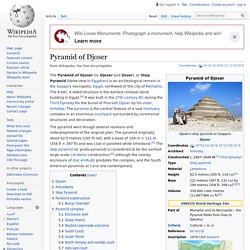
The pyramid originally stood 62.5 metres (205 ft) tall, with a base of 109 m × 121 m (358 ft × 397 ft) and was clad in polished white limestone. The step pyramid (or proto-pyramid) is considered to be the earliest large-scale cut stone construction,[6] although the nearby enclosure of Gisr el-Mudir predates the complex, and the South American pyramids at Caral are contemporary. Perspective view, plan and elevation images Djoser's Pyramid Complex taken from a 3d model Djoser[edit] Imhotep. Statuette of Imhotep in the Louvre Traditions from long after Imhotep's death treated him as a great author of wisdom texts[2] and especially as a physician.[3][4][5][6][7] No text from his lifetime mentions these capacities and no text mentions his name in the first 1200 years following his death.[8][9] Apart from the three short contemporary inscriptions that establish him as chancellor to the pharaoh, the first text to reference Imhotep dates to the time of Amenhotep III (c. 1391–1353 BC).

It is addressed to the owner of a tomb, and reads: The wab-priest may give offerings to your ka. The wab-priests may stretch to you their arms with libations on the soil, as it is done for Imhotep with the remains of the water bowl.— D. Wildung (1977), Egyptian Saints: Deification in Pharaonic Egypt, p. 34. It appears that this libation to Imhotep was done regularly, as they are attested on papyri associated with statues of Imhotep until the Late Period (c. 664–332 BC). Historicity[edit] ^ "Imhotep".
Pythius of Priene. Caryatid. A caryatid (/ˌkæriˈætɪd/ KARR-ee-AT-id; Greek: Καρυάτις, plural: Καρυάτιδες) is a sculpted female figure serving as an architectural support taking the place of a column or a pillar supporting an entablature on her head.
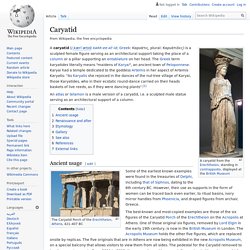
The Greek term karyatides literally means "maidens of Karyai", an ancient town of Peloponnese. Juan Bautista Villalpando. Juan Bautista Villalpando also Villalpandus, or Villalpanda (1552 – 22 May 1608) was a Spanish priest of Sephardic ancestry, a member of the Jesuits, a scholar, mathematician, and architect.
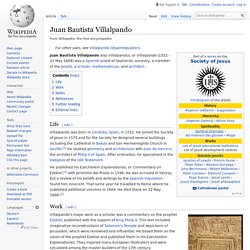
Life[edit] Villalpando was born in Córdoba, Spain, in 1552. He joined the Society of Jesus in 1575 and for the Society he designed several buildings including the Cathedral in Baeza and San Hermenegildo Church in Seville.[1] He studied geometry and architecture with Juan de Herrera, the architect of Philip II of Spain. After ordination, he specialised in the exegesis of the Old Testament. He published his Ezechielem Explanationes, or Commentary on Ezekiel,[2] with Jerónimo del Prado in 1596. Ludwig II of Bavaria. Ludwig II (German: Ludwig Otto Friedrich Wilhelm; English: Louis Otto Frederick William; 25 August 1845 – 13 June 1886)[1] was King of Bavaria from 1864 until his death in 1886.
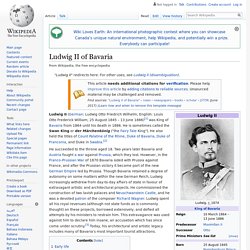
He is sometimes called the Swan King or der Märchenkönig ("the Fairy Tale King"). He also held the titles of Count Palatine of the Rhine, Duke of Bavaria, Duke of Franconia, and Duke in Swabia.[2] He succeeded to the throne aged 18. Two years later Bavaria and Austria fought a war against Prussia, which they lost. John Ruskin. Andrea Palladio. Italian architect Andrea Palladio ( pə-LAH-dee-oh, Italian: [anˈdrɛːa palˈlaːdjo]; 30 November 1508 – 19 August 1580) was an Italian Renaissance architect active in the Venetian Republic.
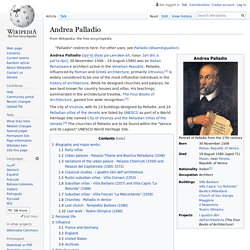
Palladio, influenced by Roman and Greek architecture, primarily Vitruvius, is widely considered to be one of the most influential individuals in the history of architecture. While he designed churches and palaces, he was best known for country houses and villas. Juan Bautista Villalpando. Giovan Giacomo Paleari Fratino. Giovan Giacomo Paleari Fratino (1520–1586), known as El Fratin or Il Fratino ("The Little Friar"), was a military engineer who served the Spanish Emperor Charles V, and then his son Philip II of Spain.
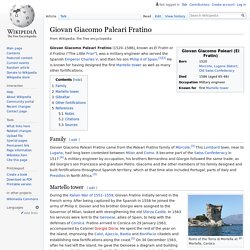
He is known for having designed the first Martello tower as well as many other fortifications. Family[edit] Giovan Giacomo Paleari Fratino came from the Paleari Fratino family of Morcote. This Lombard town, near to Lugano, had long been contested between Milan and Como. Sharawadgi. Sharawadgi or sharawaggi is a style of landscape gardening or architecture in which rigid lines and symmetry are avoided to give the scene an organic, naturalistic appearance. Michael Ventris. British classicist and philologist who deciphered Linear B Michael George Francis Ventris, OBE (; 12 July 1922 – 6 September 1956) was an English architect, classicist and philologist who deciphered Linear B,[1] the ancient Mycenaean Greek script.
A student of languages, Ventris had pursued the decipherment as a personal vocation since his adolescence. Break The Code. Smithsonian American Art Museum. Sistine Chapel ceiling - Wikipedia. The interior of the Sistine Chapel showing the ceiling in relation to the other frescoes. The Sistine Chapel ceiling, painted by Michelangelo between 1508 and 1512, is a cornerstone work of High Renaissance art. Michelangelo. Lives of the Most Excellent Painters, Sculptors, and Architects. 16th-century book of artist biographies by Giorgio Vasari. Christian de Portzamparc - Wikipedia. 2003-2008 Hotel Renaissance Wagram in Paris 2001-2009 Hergé museum, Louvain-la-Neuve in Belgium. Buckminster Fuller. Neuro-architecture Tatebayashi. Hizume Akio English Top Page. Hizume Akio English Top Page.